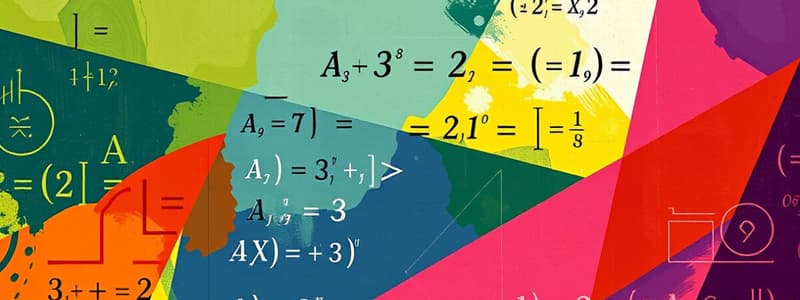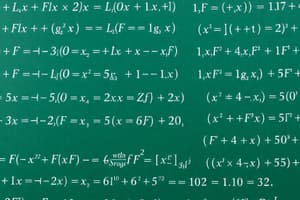Podcast
Questions and Answers
What is the primary purpose of using variables in algebra?
What is the primary purpose of using variables in algebra?
- To represent unknown values (correct)
- To simplify expressions only
- To represent fixed numerical values
- To denote operations performed on constants
What is the standard form of a linear equation?
What is the standard form of a linear equation?
- ax^2 + bx + c = 0
- ax + b = c
- a(x - b) = 0
- ax + b = 0 (correct)
Which method is NOT used to solve quadratic equations?
Which method is NOT used to solve quadratic equations?
- Linear programming (correct)
- Completing the square
- Quadratic formula
- Factoring
What defines a function in algebra?
What defines a function in algebra?
Which of the following is an example of an exponential function?
Which of the following is an example of an exponential function?
What is the result of the expression x^2 - 1 after factoring?
What is the result of the expression x^2 - 1 after factoring?
Which of the following correctly describes abstract algebra?
Which of the following correctly describes abstract algebra?
In a system of equations, what is true regarding the variables?
In a system of equations, what is true regarding the variables?
Flashcards are hidden until you start studying
Study Notes
Algebra
-
Definition: A branch of mathematics dealing with symbols and the rules for manipulating those symbols. It includes solving equations and understanding mathematical relationships.
-
Key Concepts:
- Variables: Symbols (like x, y) used to represent unknown values.
- Constants: Fixed values (like numbers) that do not change.
- Expressions: Combinations of variables and constants using operations (e.g., 3x + 2).
- Equations: Mathematical statements asserting that two expressions are equal (e.g., 2x + 3 = 7).
-
Operations:
- Addition and Subtraction: Combining or removing values.
- Multiplication and Division: Scaling values and distributing them.
- Exponentiation: Raising a quantity to a power (e.g., x^2).
-
Types of Algebra:
- Elementary Algebra: Basic operations and expressions, solving linear equations.
- Abstract Algebra: Studies algebraic structures such as groups, rings, and fields.
- Linear Algebra: Concerns vector spaces and linear mappings between them.
-
Linear Equations:
- Form: ax + b = 0, where a and b are constants.
- Solutions: Found by isolating the variable (e.g., x = -b/a).
-
Quadratic Equations:
- Form: ax^2 + bx + c = 0, where a, b, and c are constants, and a ≠ 0.
- Solutions: Found using:
- Factoring
- Completing the square
- Quadratic formula: x = (-b ± √(b² - 4ac)) / (2a)
-
Functions:
- Definition: A relation that assigns exactly one output for each input.
- Notation: f(x), where f is the function and x is the input.
- Types include linear functions (y = mx + b), polynomial functions, and exponential functions.
-
Factoring:
- Breaking down expressions into products of simpler expressions (e.g., x^2 - 1 = (x - 1)(x + 1)).
- Useful in solving equations and simplifying expressions.
-
Systems of Equations:
- A set of equations with multiple variables.
- Solutions can be found using:
- Substitution method
- Elimination method
- Graphical method
-
Inequalities:
- Expressions that use inequality signs (<, >, ≤, ≥).
- Solutions represent ranges of values.
-
Applications:
- Used in various fields such as physics, engineering, economics, and more to model real-world problems and relationships.
Definition of Algebra
- Branch of mathematics focused on symbols and rules for manipulation.
- Involves solving equations and understanding relationships between mathematical elements.
Key Concepts
- Variables: Symbols (e.g., x, y) representing unknown values.
- Constants: Fixed values that remain unchanged (e.g., numbers).
- Expressions: Combinations of variables and constants using mathematical operations (e.g., 3x + 2).
- Equations: Mathematical assertions of equality between two expressions (e.g., 2x + 3 = 7).
Operations in Algebra
- Addition and Subtraction: Combine or remove values.
- Multiplication and Division: Scale values or distribute them.
- Exponentiation: Raise a quantity to a specified power (e.g., x²).
Types of Algebra
- Elementary Algebra: Focuses on basic operations, expressions, and solving linear equations.
- Abstract Algebra: Explores algebraic structures like groups, rings, and fields.
- Linear Algebra: Studies vector spaces and linear mappings.
Linear Equations
- General Form: ax + b = 0, where a and b are constants.
- Finding Solutions: Isolate the variable to determine values (e.g., x = -b/a).
Quadratic Equations
- General Form: ax² + bx + c = 0, with a, b, and c as constants and a ≠ 0.
- Solution Methods:
- Factoring: Break down into simpler components.
- Completing the Square: Rearrange to create a perfect square.
- Quadratic Formula: x = (-b ± √(b² - 4ac)) / (2a).
Functions
- Definition: Relation assigning one output for each input.
- Notation: f(x) represents the function with x as the input.
- Types: Includes linear (y = mx + b), polynomial, and exponential functions.
Factoring
- Process of breaking down expressions into simpler multiplicative forms (e.g., x² - 1 = (x - 1)(x + 1)).
- Important for solving equations and simplifying mathematical expressions.
Systems of Equations
- Involves multiple equations with several variables.
- Solutions can be derived through:
- Substitution Method: Replace one variable with an expression from another equation.
- Elimination Method: Add or subtract equations to eliminate a variable.
- Graphical Method: Use graphical representations to find intersections that denote solutions.
Inequalities
- Statements involving inequality symbols (<, ≤, ≥).
- Solutions describe ranges of values rather than specific solutions.
Applications of Algebra
- Essential in fields like physics, engineering, and economics for modeling and solving real-world problems and relationships.
Studying That Suits You
Use AI to generate personalized quizzes and flashcards to suit your learning preferences.




